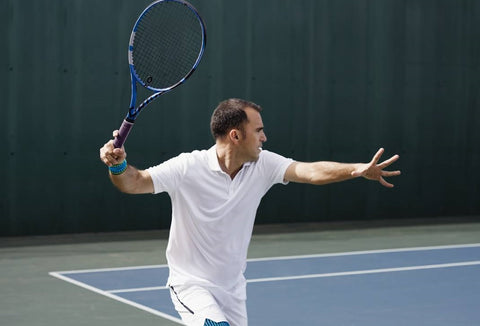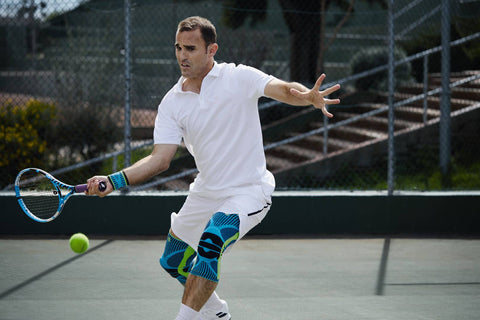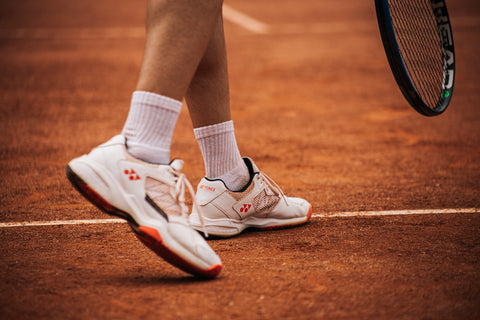5 Common Tennis Injuries and How to Avoid Them

Picking it up because you were inspired by the Australian Open? Just wanted to do something more exciting than going to the gym? Either way, tennis is a fun way to get a full-body workout. However, it does open you up to some annoying (and some gnarly) injuries. So, to make your tennis experience more enjoyable and pain-free, we’re breaking down 5 common tennis injuries and how to avoid them.
Tennis elbow
What is it
Tennis Elbow is an overuse injury in which the outer (lateral) epicondyle tendon inflames. When you spend long periods tightly gripping your racquet and moving your wrist, your forearm muscles fatigue, causing this tendon to pick up the slack. And without the support of these muscles, the tendon can develop micro tears and inflame, leading to pain, swelling, and stiffness through the hand and forearm.
How to avoid this tennis injury
While working your forearm muscles is unavoidable in tennis, there are ways to avoid Tennis Elbow:
- Strengthen your forearm muscles and grip. You can check out some of the exercises we discussed in our Golfer’s Elbow article. You might also invest in a grip strengthener or a stress ball: the better your grip, the less stabilisation work your forearm muscles need to do.
- Rest. To avoid overuse, give your hands and arms plenty of rest between practices and matches. And remember, tennis isn’t the only thing that causes Tennis Elbow. Activities like cooking, typing, and playing video games all use this muscle group. Hence, doing too much of them between your games is also not a great idea.
- Get a brace. Our EpiTrain Elbow Brace, for example, incorporates medical-grade compression knit and gel padding. These will act as an additional layer of support for your elbow tendons and help you better activate your forearm muscles to avoid fatiguing. And for even more support, you can add in the EpiTrain Forearm Strap.
Learn more: Tennis Elbow Brace: How to Pick the Best one for You
Wrist strain
What is it
A wrist strain is a wrist tendon injury. It can either come on gradually from overuse or happen suddenly with too much force. Tennis players can develop this injury due to weak or unprepared forearm muscles, being unaccustomed to the weight of their racket, sharp, sudden wrist movements, or even a fall. With a wrist strain, you may get some swelling, tenderness, and wrist pain.
How to avoid this tennis injury
As with Tennis Elbow, you can generally avoid this injury through sufficient rest, strengthening your grip, and good support. Here, we’d recommend the Sports Wrist Strap. It’ll help stabilise the wrist joint and improve your grip, taking some pressure off your forearm muscles.

Sports Wrist Strap
Rotator cuff tendonitis
What is it
Rotator cuff tendonitis is also an overuse injury. It affects the rotator cuff tendons and causes a dull ache deep in the shoulder, swelling of the bursae (tissues that cushion your tendons), difficulty reaching overhead, and arm weakness. In tennis, rotator cuff tendons will usually become inflamed due to a lot of overhead hits and serves, or when you don’t properly position your elbow and forearm in forehand hits.
How to avoid this tennis injury
First and foremost, make your shoulder muscles stronger and your upper back looser through exercises like Internal Rotations and Thoracic Spine Extension. You can check out how to do these and other great shoulder exercises in our Swimmer’s Shoulder article.
Rest will also go a long way, as will a shoulder brace. Our OmoTrain S will come in especially handy if you have some weakness or instability from an old injury.
And last but not least, practise proper technique. The most important tips here are to hold your racquet perpendicular to your forearm and keep the angle between your arm and side at 135 degrees on overhead hits.
Patellar tendonitis
What is it
Also known as Jumper’s Knee, Patellar Tendonitis is tendonitis affecting the tendon that attaches the kneecap to the tibia. With this condition, you’ll likely experience pain under your kneecap, redness, and some swelling.
Patellar Tendonitis might come on gradually from overuse and improper positioning, or suddenly through excessive force (like if you stop suddenly on a bent knee after a dead sprint).
How to avoid this tennis injury
- Stretch your quads and hammies. You can try incorporating Downward Facing Dog and Quad Stretch into your cooldown routine.
- Get good foot support. DO NOT play in worn-out sneakers and give your feet some extra support through Performance Insoles. Remember, your knee's movement largely depends on the placement and roll of your ankle. So, the better your ankle aligns, the less your knee tendons have to work to compensate.
- Strengthen your knees. Wall Squats, Clam Shells, and Hamstring Curls are a great place to start. See how to do them here.
- Try a knee brace. Something like our Sports Knee Support will protect your patellar tendon and improve how your joint moves without sacrificing mobility.

Sports Knee Support
Tennis toe
What is it
This one’s a little different to the other injuries on this list. Tennis Toe develops when your big toe jams into the front edge of your shoe one too many times, which often happens during quick starts and stops. Due to the jamming, you can develop a painful haemorrhage under your toenail. In some cases, the toenail can dislodge from the nail bed.
How to avoid this tennis injury
We know that slowing down on the court isn’t exactly a viable option. Instead, you can:
- Keep your toenails short. The edges should stop a few millimetres before the end of your toe to avoid getting them caught on your sock or shoe netting.
- Wear padded socks. Our Outdoor Socks have specialised padding around the toes to help prevent injuries like this.
- Get well-fitted shoes. Your toes should have adequate space between them and stop a little way away from the front of your shoe. At the same time, your shoes can’t be too big, as too much space will cause your foot to slide toe-first to the front.
To sum up
Tennis is a fun activity that provides a full-body workout. But that also means you put many parts of your body at risk. Fortunately, most injuries won’t be severe. Taking some precautions like getting good support, plenty of rest, and incorporating a few specific exercises into your routine can help you avoid them.
Play tennis often? Check out our collections of tennis supports and sleeves.
If you require assistance selecting the right product for your needs or wearing the brace, call us on 1300 668 466 or contact us via live chat.
Do you have private health? Most private health extras will cover Bauerfeind Products, check to see if yours is included. Bauerfeind Private Health Insurance Inquiry.




